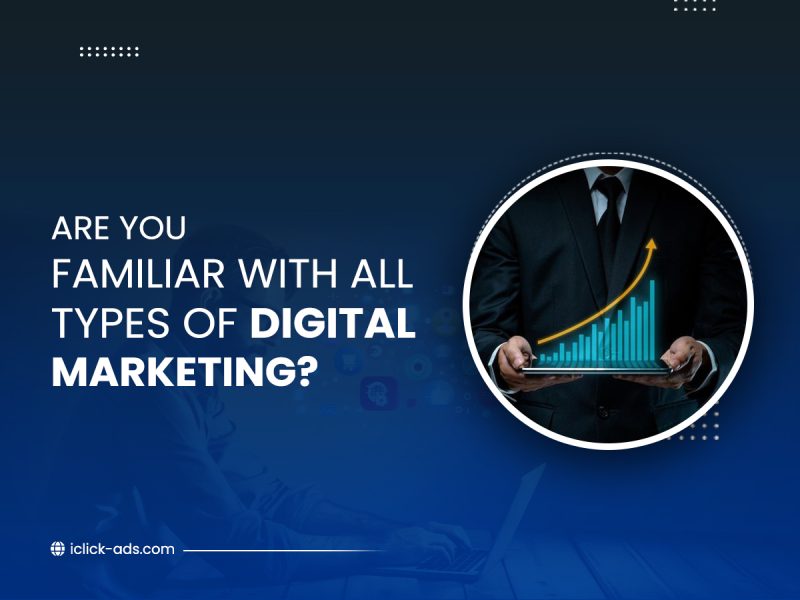Digital marketing is the promotion of products and services using digital channels like the internet, social media, search engines, and email. It involves a variety of tactics such as search engine optimization (SEO), content marketing, social media marketing, and paid advertising to reach and engage potential customers online. The goal is to connect with a target audience where they spend time and to use data to track results and personalize messages. Let’s dive into digital marketing types to fully understand the topic.
1. (SEO) – Search Engine Optimization
Enhancing a website to rank higher in search engine results, such as Google, is known as SEO. and in order to draw in organic (free) traffic, it emphasizes the use of appropriate keywords, compelling content, and improved site performance.
Three simple examples:
1: To appear higher in search results, a travel agency employs phrases like “top Dubai tours.”
2: To boost traffic, a blogger writes useful guides.
3: An online retailer improves its product descriptions so that Google displays them more frequently.
2. (SEM) – Search Egine Marketing:
SEM entails paying search engines to show your advertisements when users search for specific terms or phrases. It’s an efficient and focused method of using paid advertisements to increase website traffic.
For Examples:
1: “Buy sneakers online” advertisements are paid for by a footwear company.
2: “Apartments for sale in Kabul” is advertised by a real estate company.
3: When people search for “best pizza near me,” a fast-food restaurant pays for the advertisements that appear.
3. (SMM) – Social Media Marketing:
Social media marketing makes use of sites like Facebook, Instagram, LinkedIn, and TikTok to connect with consumers, reach audiences, and promote content. For interaction, it depends on posts, tales, reels, and comments.
For instance:
1: One On Instagram, a designer boutique posts pictures of its latest collection.
2: A business shares client endorsements on Facebook.
3: To gain fans, a motivational speaker posts brief videos to TikTok.
4. Content Marketing:
Instead of aggressively promoting sales, this approach focuses on disseminating pertinent and useful information to draw people in organically. It establishes your brand as an authority and fosters long-term trust.
For instance:
1: A beauty company publishes blog entries such as “Easy steps to healthy skin.”
2: Free eBooks about internet trends are available from a digital agency.
3: “How to design social media posts with Canva” is taught by a YouTuber.
5. Email Marketing:
Businesses can deliver messages straight to clients’ inboxes using email marketing. It’s a customized method of disseminating news, promotions, or updates that keep the audience engaged.
Examples:
1: Subscribers receive weekly discount offers from an online retailer.
2: A business uses newsletters to provide information about new items.
3: A resort sends previous visitors an email with “holiday season packages.”
6. Marketing using Influencers:
Influencer marketing is collaborating with well-known social media figures who genuinely advocate your product to their audience. Through reliable recommendations, it assists brands in reaching new audiences.
Examples Below:
1: To promote its products, a fitness influencer is sponsored by a gymwear brand.
2: A food blogger is invited by a café to review their menu.
3: A YouTuber receives new devices from a tech company for an unboxing video.
7 Affiliate Marketing:
Affiliate marketing is a performance-based strategy in which partners, or affiliates, market your products and receive a reward each time a transaction is made via their unique link.
Examples:
1: A blogger can make money by endorsing things on Amazon.
2: In tutorial videos, a YouTuber posts affiliate links.
3: A percentage is paid to a travel website for each hotel reservation made via its links.
8. (PPC ) – pay-per-click advertising:
Another type of digital marketing is PPC. Paying just when someone clicks on your advertisement is known as PPC. It is frequently utilized to swiftly draw in new clients on Google Ads, Facebook Ads, and other platforms of a similar nature.
For instance:
1: An online school uses Google Ads to advertise “virtual English classes.”
2: “Custom logo design services” are advertised by a freelance designer.
3: Ads for a mobile app urge consumers to “download our free app.”
9. Video Marketing:
Video marketing uses engaging videos to promote a brand, tell stories, or explain how products work. Videos can be educational, emotional, or entertaining to capture attention.
For Examples:
1: A company posts customer success videos on YouTube.
2: A tech startup creates a short demo of how their product functions.
3: A restaurant uploads recipe clips on Instagram Reels.
10. Mobile Marketing:
Mobile marketing focuses on communicating offers and updates to people via their smartphones via text messages, push notifications, or mobile apps.
For further clarification, read the examples below:
1: Notifying recipients via SMS about exclusive deals.
2: Using an app to tell people about flash sales.
3: Creating a mobile-friendly website to facilitate browsing and purchasing.
11. (Digital PR) – Online Public Relations:
By gaining favorable attention from bloggers, influencers, and online media, digital PR controls a brand’s online reputation. It fosters public trust and credibility.
Also read the following examples:
1: A press release is posted on internet news portals by a new company.
2: A business responds to client reviews with courtesy.
3: A brand leader participates in an online interview to discuss recent accomplishments.





